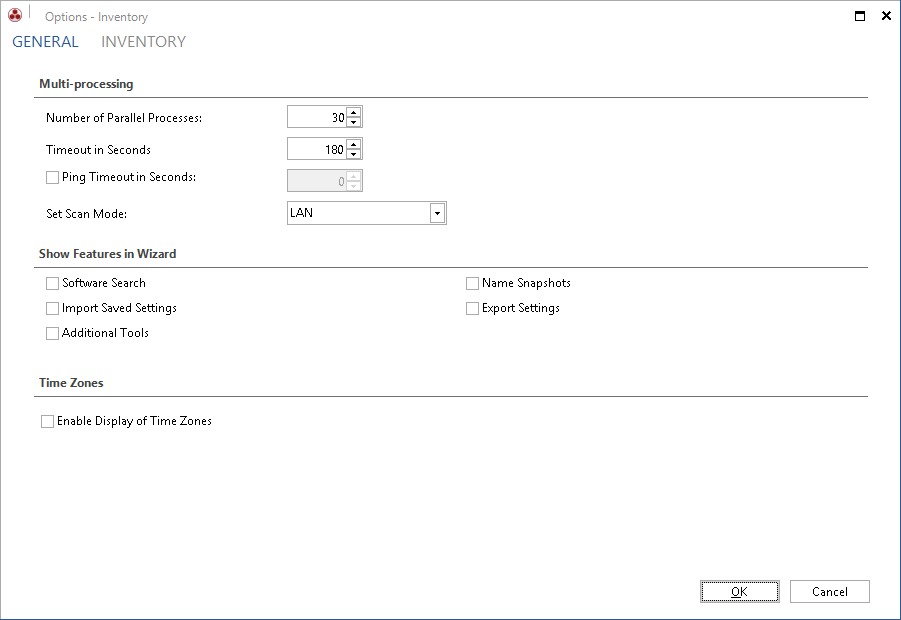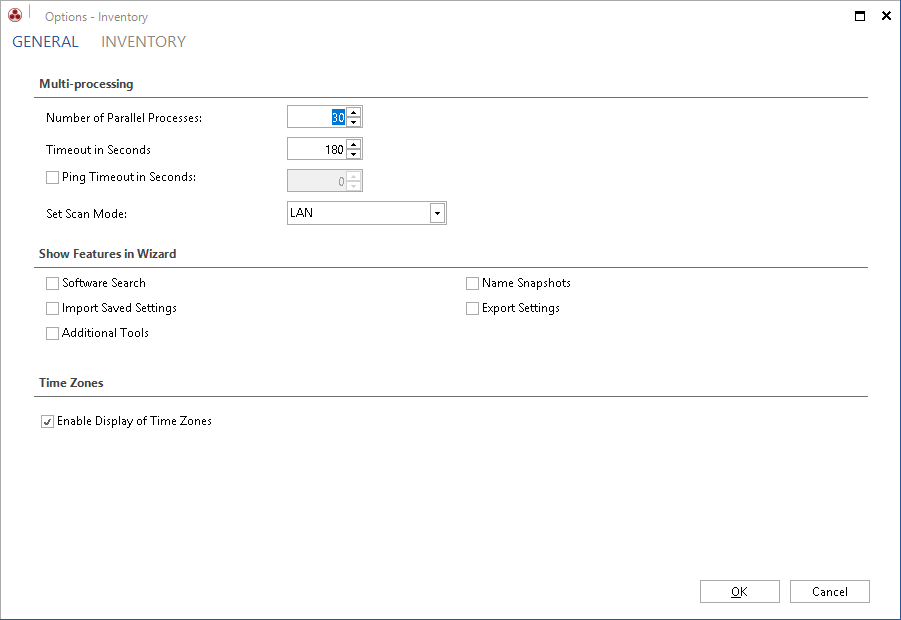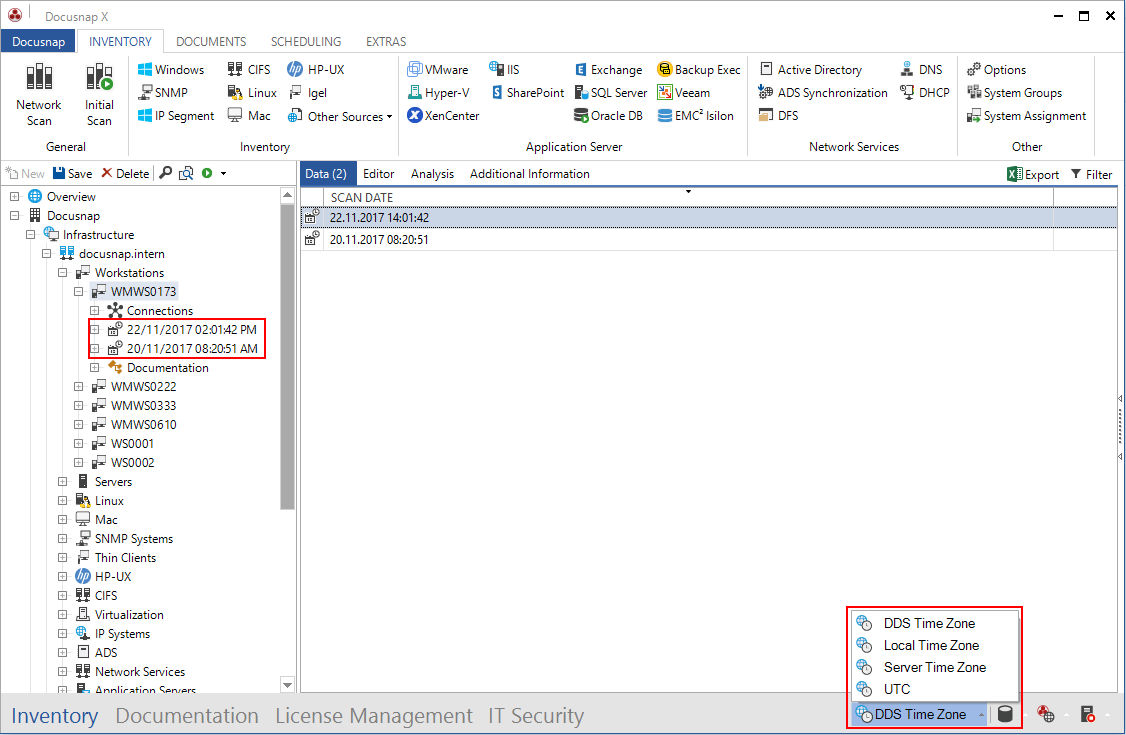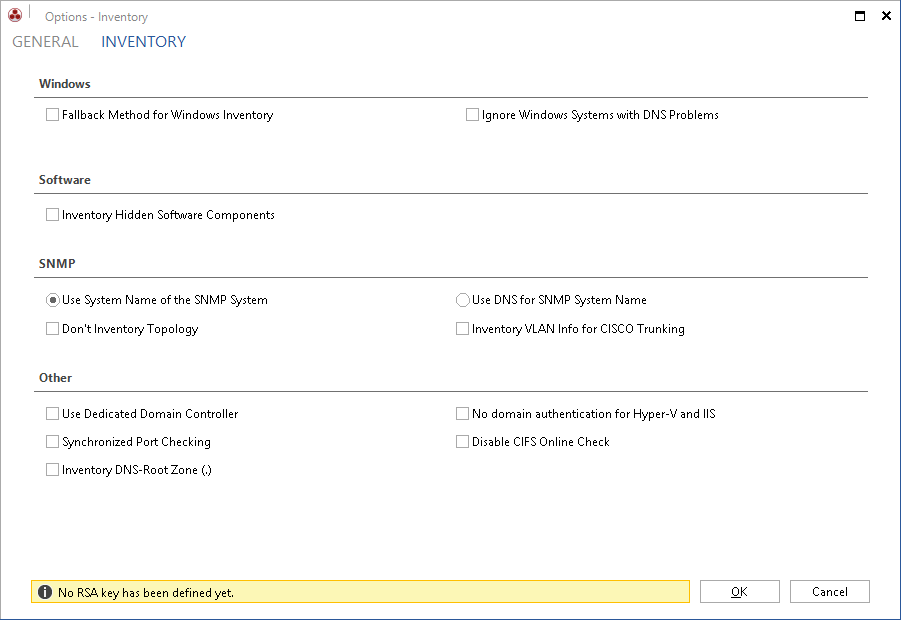
Settings for the execution of the inventory can specified in the Options - Inventory dialog. Click the Options button in the Inventory ribbon or the Inventory button in the Docusnap Menu to open the dialog.
General
Multi-Processing
In order to accelerate tasks such as inventorying Windows systems, Docusnap performs multiple tasks in parallel. By default, 30 concurrent processes can be performed.
The Timeout in Seconds field indicates how long Docusnap will wait for the completion of a process during an inventory scan before a timeout occurs. If, for example, a Windows server is scanned over a WAN, it may take longer than 180 seconds until all information has been gathered. If the defined time period is exceeded, Docusnap will terminate the inventory process with a "Timeout" error.
|
In case of problems during an inventory scan performed over a WAN, reduce the number of concurrent processes and, at the same time, increase the timeout value. Docusnap uses roughly 250 kbits/s for each process. |
- Ping Timeout in Seconds: This option enables you to increase the ping timeout value for the systems during an inventory process up to 20 seconds.
- Set Scan Mode
Remote or slow networks may cause information retrieval problems as too many concurrent processes are transferring data across the network.
- If you select the WAN mode, Docusnap automatically reduces the number of parallel processes to two and doubles the Timeout value.
- If you select the LAN mode, the settings from the Multi-processing group will be applied.
Show Features in Wizard
In Docusnap, you can extend the wizards by including additional steps (Export Settings, Software Search, etc.).
- Software Search
Software Search allows you to find software that cannot be scanned automatically due to a missing registry entry. If you enable the Software Search feature on the Options dialog, the wizards will include the additional Software Search step that you can use to list and select defined software products (see: Software Search).
- Name Snapshots
For each inventory scan, Docusnap creates a snapshot. Snapshots will be automatically named Inventory from, with the current timestamp appended to it. After enabling the Name Snapshot checkbox in this dialog, you can name the snapshots as desired.
- Exporting Settings / Importing Saved Settings
You can use the Import step in the wizards to load a saved configuration. This option is particularly helpful if you need to perform inventory scans repeatedly and with the same settings. When you select the desired configuration file, the settings saved in this file will be reused. Only the authentication step must be repeated.
You can save the current configuration of the wizard using the Export step and reload it by selecting the Import step, as needed. This option is particularly helpful if you need to perform inventory scans repeatedly and with the same settings.
- Additional Tools
Additional tools are used to integrate external utilities into the inventory process for Windows systems. You can add these tools in the Docusnap Management.

Time Zones
When systems are inventoried with several Discovery Service, which are in different time zones, the scheduling and the display can be confusing. For this reason, it is possible to activate the time zone display. This allows you to define during the scheduling whether the specified time refers to the respective time zone of the discovery service or the time zone of the Docusnap server or if the time is assumed to be UTC time.

By activating the Display of Time Zones, the output of the scan date can be adjusted in the data explorer. In the status bar of Docusnap it can be selected which time zone is used for the display.
- DDS Time Zone: For each Discovery Service is stored in what time zone it is located. If the DDS Time Zone setting is selected, the data explorer displays the time that the Discovery Service had at the time of the inventory.
- Local Time Zone: If the Local Time Zone setting is selected, then the time of inventory is displayed at local time. If the installation of Docusnap and the Discovery Service are in the same time zone, nothing changes in the display.
- Server Time Zone: If the Server Time Zone setting is selected, the data explorer displays the time that the Docusnap Server had at the time of the inventory. Regardless if the the inventory was executed with the Docusnap Client, the Docusnap Server or a Discovery Service.
- UTC: With the UTC setting, all times are displayed as UTC time.

Inventory
Windows
- Fallback Method for Windows Inventory
The fallback method can be activated when the standard way of inventorying systems doesn't work for all Windows systems, for example, if the WMI port is not available. Is this method enabled the remote DocusnapScript.exe will be executed on the devices to obtain the data of the inventory in this way.
- Ignore Windows Systems with DNS Problems
Selecting this option systems are ignored, for which problems with the DNS resolution occur.
Software
- Inventory Hidden Software Components
If you enable the Inventory Hidden Software Components checkbox, Docusnap will also include invisible software categories in the inventory scan (some software providers define their software such that not all areas are visible).
SNMP
- Using the DNS or Device Name for SNMP Inventory
For the SNMP inventory you can use, the device name or the DNS name, if it has been maintained. If the Use System Name of the SNMP Device option is selected, then the MAC address is added to the name, if the same device name was used more than once. If the Use DNS for SNMP System options is selected and the DNS resolution is not available, the IP address is used as the name.
- Don't Inventory Topology
Enable this checkbox if you do not want the topology of the SNMP devices to be scanned during an SNMP inventory process. - Inventory VLAN Info for CISCO Trunking
Scanning the VLAN information during SNMP inventory of CISCO switches can significantly slow down the creation of the VLAN plan. For this reason, the option is currently disabled by default.
Other
- Use Dedicated Domain Controller
By enabling Use Dedicated Domain Controller, you can specify the domain controller to be used for listing the systems found during the inventory scan. For example, if the domain controllers are distributed to multiple sites, this can dramatically reduce the response times when querying the Active Directory. If this option is enabled, you need to specify the name of the dedicated domain controller in the Authentication step of the Inventory wizard.
- No domain authentication for Hyper-V and IIS
In order to scan Hyper-V and IIS devices that are not attached to any domain, you need to disable domain authentication.
- Synchronized Port Checking
A Windows, Linux, Mac, or IP inventory process searches the network for the systems available for scanning. This search runs asynchronously. If systems which exist in the network are not listed, you can alternatively enable the Synchronized Port Checking feature in the Options dialog. A synchronous search takes more time.
- Disable CIFS Online Check
To inventory CIFS which do not respond to a ping, you must disable the CIFS online check. This way, the CIFS inventory starts without waiting for a response from CIFS.
- Inventory DNS Root Zone (.)
If you enable the Inventory DNS Root Zone (.) checkbox, Docusnap will also determine the (.) root zone entries in the forward lookup zones when inventorying the DNS servers.


